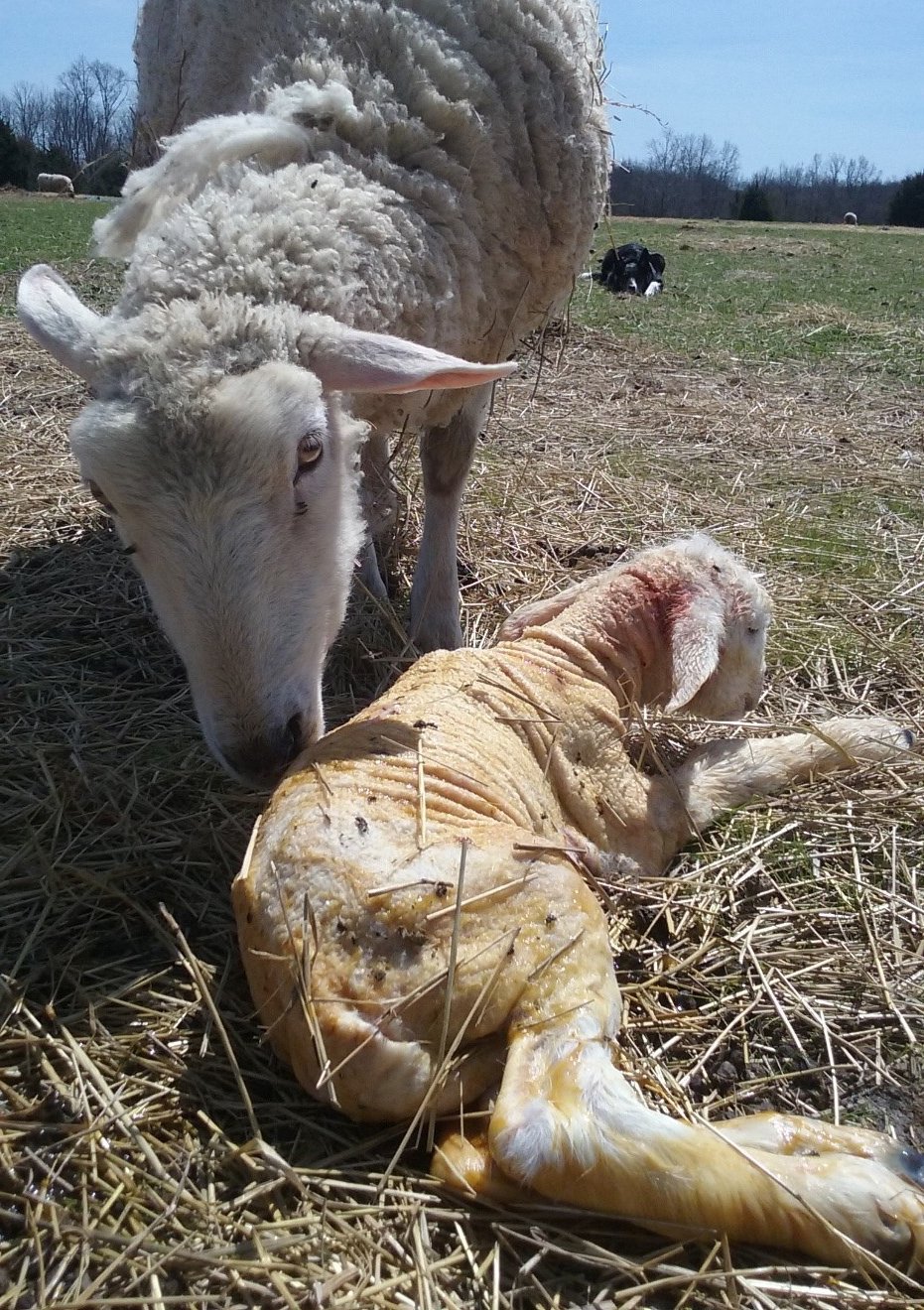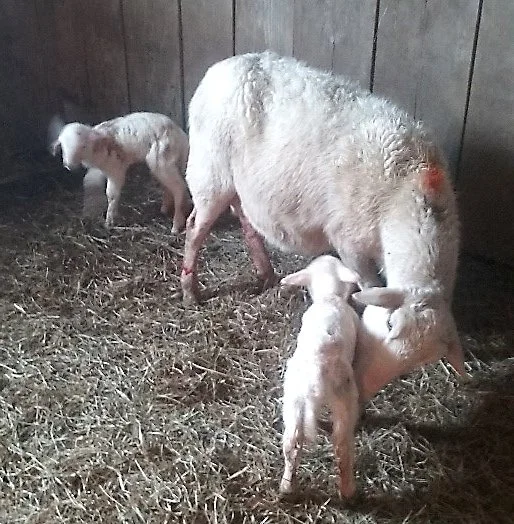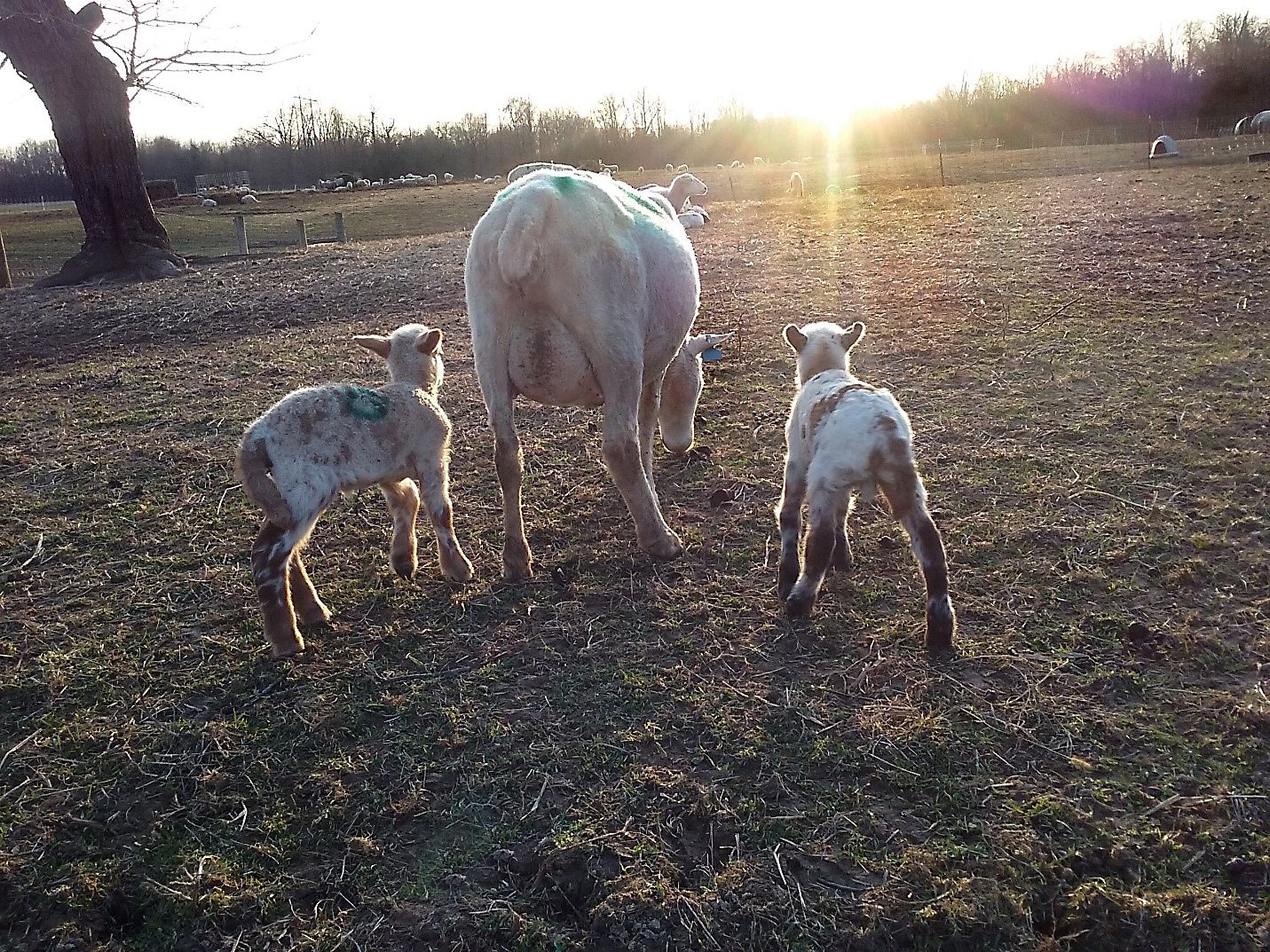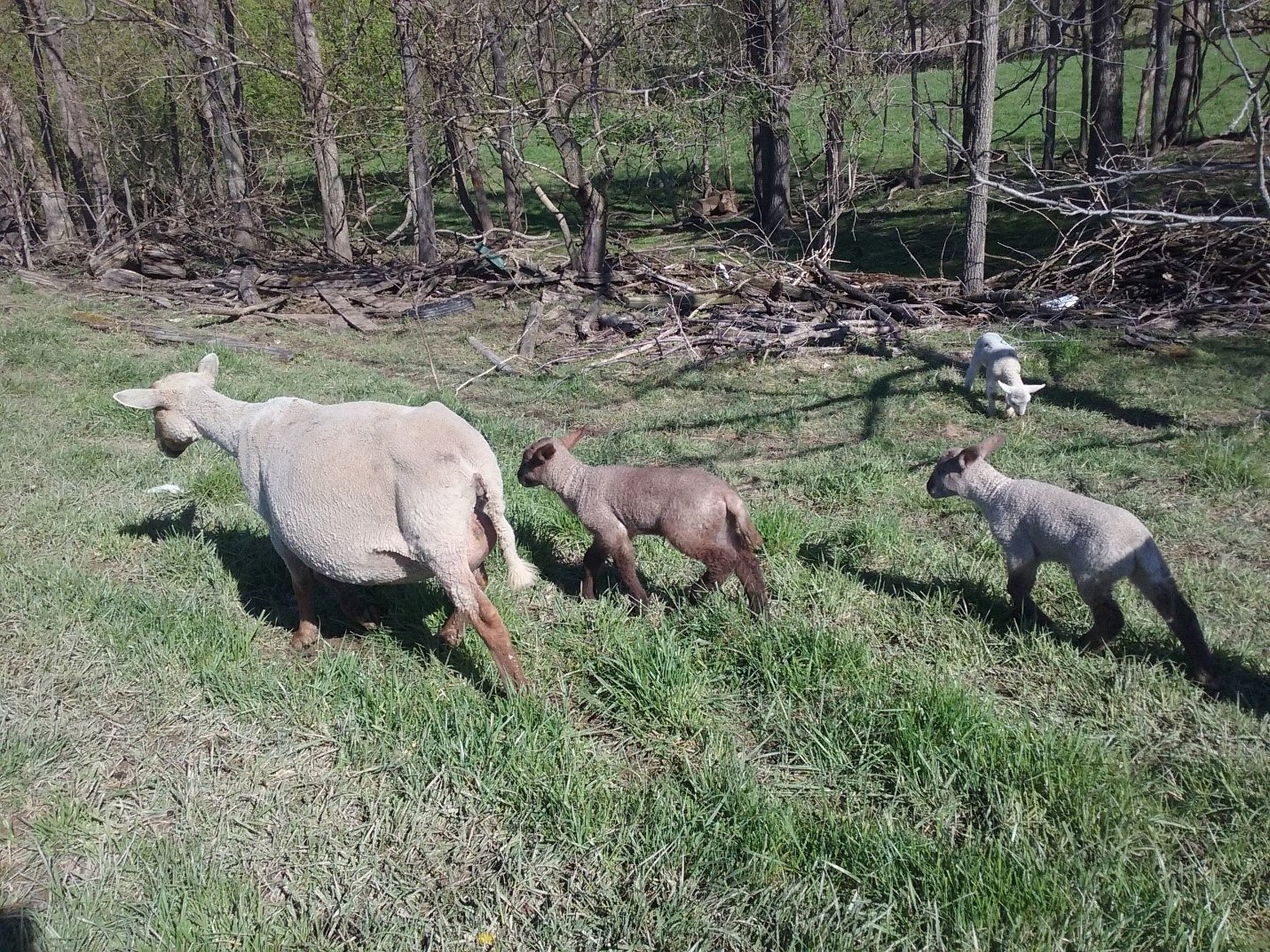BARN and PASTURE LAMBING– Pros and Cons
By Denice Rackley
Few things are more satisfying to livestock producers than witnessing new life begin. Slimy, soaking wet, wobbling legged lambs who nose dive as they attempt to stand bring us joy. Finally, on their feet nuzzling the wrong end of mom in search of the fist meal – we anticipate the arrivals for months.
Autumn’s crisp mornings arrive before we know it, the cool breezes and increasingly earlier sunsets remind us summer is on the downhill slide. Each fall sheep producers are faced with a decision that impacts every other choice for the next year – “When should I put a ram with the ewes?”
“From a profitability standpoint, the single most important decision you can make is when to lamb. That is because the costliest animal to feed is the lactating ewe….,” says Dr. Bob Leader, DVM.
Answering the question, “When should we lamb?” will dictate the timing of events for the next 12 months. As much as we look forward to the first birth, we also know that the year's success is tied to live, healthy lambs.
Lambing generally falls into two categories – shed or barn lambing in winter or pasture lambing in spring. There are breeds of sheep you can manage intensively to have multiple lambings in a year. Some sheep breeds will successfully lamb in the fall, but this discussion will deal with lambing one a year in the more traditional lambing seasons (Dec-May).
Ewes begin to cycle as day length shortens. Most ewes have two heat cycles a month, every 15 to 18 days for 24 to 48 hours. Lambs arrive in about 5 months (average 148 days). Deciding when lambs should be born will tells you when the rams need to enter the ewe pasture.
There are many factors to consider when deciding which lambing system, barn or pasture, would work best. Some considerations are more significant and should weigh heavily:
· climate
· available shelter
· feed costs
· available labor
· disease
· predation
· markets - patterns of market highs and lows
· goals for your flock
How do you make the choice between winter and spring-born lambs? Let’s look at some of the pros and cons of both systems.
In the Midwest, winter lambing means lambs will need to be born in a barn or at least have access to shelter while spring lambing can be accomplished on pasture.
The most significant advantage of winter shed lambing is that every part of the process can be managed. Winter lambing the flock means they are close at hand to make hands on management more timely. Pasture lambing, when ewes are grazing, means they have feed at their feet. Chores are simpler, but intervention and management are not as easily accomplished.
Shed or Barn Winter Lambing
Shed lambing is more labor-intensive. Feed and water are brought to ewes and pairs housed inside. The barn is bedded and cleaned. Families require adequate space so new mothers can separate themselves and their lambs from the flock to enable bonding and decrease the chance of mis-mothering.
Experts say the barn should house 10% of the flock. Once a ewe has lambed, she and her lambs are moved into a separate pen or jug. The ewe can be observed making sure she accepts all the lambs; her bag can be checked, ensuring she has two functional teats and sufficient milk supply. Tail docking and taggings are easy while lambs are penned. Bonding occurs without the possibility of interference and you can ensure all lambs are nursing well.
Most producers who use jugs, allow the family to remain for 24 hours. If there are triplets or problems, the family can stay longer. The family is then moved into a mixing pen that holds several families of similar ages for further bonding and observation. This slightly larger area ensures the ewe and lambs can locate each other and all is well before moving them into a paddock with more families.
Shed lambing also works well for bottle-lambs, an inevitable fact that accompanies raising sheep. Bottle or bum lambs need a well-bedded, draft-free pen separate from the ewes and lambs. Once trained to a bottle, they don’t require much extra time. They readily come when they see you and their bottle can be hung for them while you do other chores. Bottle lambs can be introduced to grain early. Growing well on grain will reduce the chance of bloat and reduce cost since milk replacer is expensive. A sweet feed mix with some molasses and soy meal will get lambs eating in no time.
Advantages of Shed Lambing
· Ability to winter lamb
· Easily monitor prolific ewes and lambs.
· Allows easy intervention if needed
· Intensive management often results in a high percentage of lambs weaned
· Enables more control of entire process
Disadvantages of Shed Lambing
· High capital investment for barn, pens, bedding
· High feed costs – especially compared to ewes birthing and raising lambs on pasture
· Labor Intensive- carrying feed and water to sheep, cleaning jugs, moving families
· Size of barn can restrict flock size
· Potential to spread disease with animals grouped together
Shed lambing systems are, by their very nature, labor-intensive. Checking ewes and lambs every couple of hours, carrying feed to individual pens, and cleaning and bedding pens require time. Mis-mothering potential is higher because ewes are unable to distance themselves and their lambs very far from other ewes. Mortality is typically highest in the lambs' first 30 days, so keeping a close eye on lambs and ewes can be beneficial and allow early detection and intervention if problems arise. Shed lambing can increase the chance of mastitis in ewes and pneumonia and scours in lambs, but keeping the barn clean, draft-free, and not overcrowding improves health and mothering ability of ewes.
Pasture Lambing
Pasture lambing also has advantages and disadvantages. Reduced cost of infrastructure is possibly the most significant advantage. Flock size is not limited by how many ewes can be placed inside during lambing.
The largest hurdles for those considering pasture lambing are the weather, depending on the ewes to take care of the lambs without much assistance or intervention, and the increased chance of predation. By stepping in during lambing and giving constant care that shed lambing allows we can reduce the mothering instinct in our flock. We pick up the slack for those ewes with difficult births, not enough milk, and those that lose track of their lambs.
Mothering ability is genetic. If we keep marginal ewes and their ewe lambs, we increase the work for ourselves. Pasture lambing makes those marginal ewes easy to pick out and cull problems from the flock, making our flock more self-sufficient.
Waiting till soil temps are above 45 F, and there is plenty grass available for the ewe and her lambs to remain where she chooses to give birth will add to pasture lambing success. Having shrubs or woods for a windbreak and shelter is a great asset.
In parts of the east and Midwest where spring rains can last for days, more substantial shelter may be needed. Natural shelter is usually sufficient for newborn lambs, though a contingency for foul weather is helpful. Lambs can withstand cool or even cold temperatures if they have a full belly, but continual rain can lead to health problems.
Pasture lambing reduces labor and time since carrying feed into the sheep and less cleaning is required. Most producers who pasture lamb don’t check ewes in the middle of the night. Waiting till dawn allows the ewes to remain bedded down undisturbed. Checking for new lambs at first light, through the day, and at dusk is typically sufficient to catch any problems that may occur. My personal experience is ewes that are kept on pasture all year, will give birth right before dawn and during daylight hours as natural adaptation to avoid predation.
Lambing in the spring takes advantage of improved fertility for both the ram and ewe. Delaying breeding until the middle of the breeding season can result in a 5 to 10% increase in the number of lambs born. Spring born lambs also benefit from spring, summer, and fall forages, significantly decreasing the cost of finishing.
Advantages of Pasture Lambing
· Reduced costs
· Reduced labor
· Reduced time commitment
· Daily exercise reduces dystocia (difficult births)
· Mis-mothering reduced or eliminated
· Increase fertility results in more lambs born
· Feed cost reduced
Predators, parasites, and dealing with unpredictable spring weather maybe the three largest challenges with pasture lambing. Keeping families on pasture they are not as accessible as they are in a shed lambing system. Processing ewes and lambs and record-keeping can be more challenging because you need a way to keep the ewe-and-lamb units together while you’re working with them. Ewes with lower milk production or bad mothers may lose lambs without the hands-on care and supplementation of shed lambing, but culling these individuals will improve flock health.
Predation and parasites can be a significant challenge when pasture lambing and raising lambs on pasture. Guardian animals are an added expense, but the added peace of mind knowing the flock is protected is well worth the cost. Guarding livestock is instinctual behavior. Choosing a guardian from a parent who works successfully in a similar management style will give you a better chance of success. The selection and raising of a guardian is key to having a dependable watchman caring for the flock.
Pasture lambing requires an experienced shepherd that can pick up on small changes in appearance or activity. There is no question raising small ruminants requires more hands on care, problems need to noticed and addressed early.
Sheep have no defense against predation so their only option is to hide the fact that they are not well. People will say that “sheep are just looking for a place to die.” In reality, the signs that there is a problem can be very subtle, you have to look closely and be able to pick up on small changes. Once a sheep reveals they are sick, treatment can be too late.
Parasites can be another complication when lambing on pasture. Pasture lambing and raising lambs on pasture requires more attention directed at forage growth and management. Consistent high-quality nutrition is needed for ewes to milk well and lambs to grow on pasture. Maintaining forage levels above 4 inches will reduce parasite exposure as will rotation of pastures and allowing adequate pasture rest for your particular area and forages. The exact timing of rotation is location, forage, soil health, and stocking dependent.
Rotational grazing and raising livestock on pasture is as much of an art as it is science. No two years are identical. Heavier soils, humidity, and high temperature will accelerate parasite pressure requiring faster rotations and longer rest periods.
Disadvantages of Pasture Lambing
· Weather challenges
· Intervention and treatment can be more difficult
· Management of forages is required
· Predation
· Parasites challenges
· Added expense of livestock guardian
· Moving of stock on pasture can be difficult
The need to rotate sheep through pastures, bring individuals to a handling facility, or house them temporarily in a barn requires moving families or the entire flock. Moving the flock, especially with young lambs, can be easier said than done. The rattling of a grain bucket can turn into a dangerous mob scene with sheep pushing and shoving. Lambs can be stepped on and mis-mothering can occur with moves. Understanding how and why sheep move enables efficient and less stressful movement and a healthier flock.
The most useful skills I have learned to assist in the management of a sheep flock are understanding how sheep think and move and gaining skills to use a herding dog to help in flock management. Learning to use a stock dog requires time and patience. The dog can save you a ton of time and frustration when it comes to management tasks with livestock.
Shed and pasture lambing both have advantages and disadvantages. To choose the system that is right for you, evaluate your individual situation. Take into consideration your local markets – what size lamb brings the highest return and the timing of market highs and lows. Consider weather challenges, available structures, forage availability, fencing, predator type and density, and your available time to decide if winter shed lambing or spring pasture lambing is the most feasible and will bring the best return on your investment. Keep in mind some breeds of sheep are more seasonal when it comes to breeding and lambs. Evaluating your farm, markets, goals, and personal preferences will enable you to take advantage of every opportunity and choose a lambing system that produces healthy lambs, all leading to raising sheep being an enjoyable experience.







